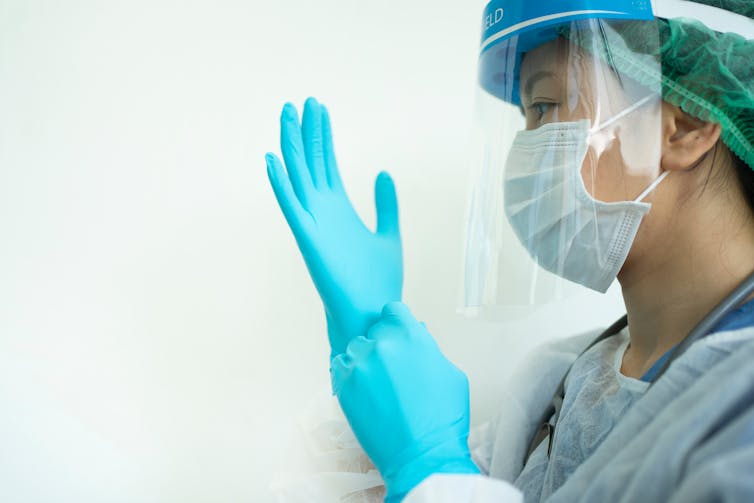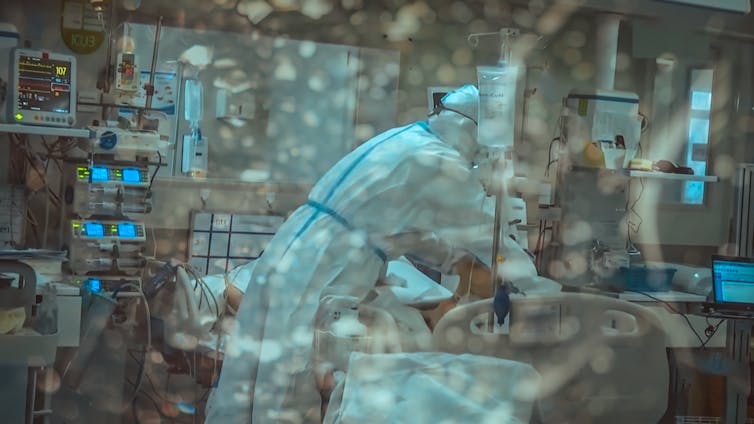People with coronavirus are at risk of blood clots and strokes. Here's what we know so far
- Written by Karlheinz Peter, Lab Head, Atherothrombosis and Vascular Biology and Deputy Director, Baker Heart and Diabetes Institute; Interventional Cardiologist, Alfred Hospital; Professor of Medicine and Immunology, Monash University, Baker Heart and Diabetes Insti
As well as causing severe respiratory problems, there is mounting evidence COVID-19 causes abnormalities in blood clotting. Patients with severe COVID-19 infection appear to be at greater risk of developing blood clots in the veins and arteries.
Blood clots can occur deep in the veins of the leg (deep vein thrombosis) and can move to the lungs, causing a pulmonary embolism, which restricts blood flow and oxygen, and can be fatal.
Read more: Explainer: what is deep vein thrombosis?
Blood clots in arteries can cause heart attacks when they block blood supply to the heart, or strokes when they block oxygen supply to the brain.
So what is going on in the bodies of people with coronavirus? And what are clinicians doing to treat or prevent this complication?
What do these clots do?
Recent data from the Netherlands and France suggest that of the patients with coronavirus who are admitted to intensive care units (ICU), 30-70% develop blood clots in the deep veins of the legs, or in the lungs.
Around one in four coronavirus patients admitted to ICU will develop a pulmonary embolism.
These rates are much higher than we would usually see in patients requiring admission to ICU for reasons other than COVID-19.
Greater risk of stroke
Patients who present to hospital with COVID-19 are also more likely to have a stroke when compared with the general population.
Typically, the chance of having a stroke is associated with increasing age, as well as other risk factors such as high blood pressure, elevated cholesterol levels, or smoking.
 Usually it’s older people who have strokes.
Shutterstock
Usually it’s older people who have strokes.
Shutterstock
However, higher rates of strokes in patients with COVID-19 is somewhat unusual because it also seems to be happening in people under 50 years of age, with no other risk factors for stroke.
Low levels of oxygen
COVID-19 also appears to be associated with blood clots in the tiny blood vessels that are important for the transfer of oxygen in organs. Autopsy reports have shown elements of SARS-CoV-2, the virus causing COVID-19, in cells lining these small blood vessels in the lungs, kidney, and gut.
This may result in tiny blood clots in these small blood vessels that disturb normal blood flow and the ability of the blood to deliver oxygen to these organs.
Read more: ICU ventilators: what they are, how they work and why it's hard to make more
Importantly, these small blood clots could reduce normal lung function. If these small blood clots reach the lungs it may prevent oxygen getting into the blood as efficiently as normal. This may explain why patients with severe COVID-19 can have very low oxygen levels.
Treating and diagnosing clots is difficult
When patients are admitted to hospital, for coronavirus or any other condition that leaves them bed-bound, it is common practice to administer low-dose blood thinners to prevent the development of blood clots.
However, given that patients with COVID-19 seem to be at a higher risk of developing blood clots, it’s currently being debated whether higher doses of blood thinners are required to prevent these clotting complications.
Trials are underway to attempt to answer this important question.
 Higher doses of blood thinners might one day play a role in treating COVID-19.
Shutterstock
Higher doses of blood thinners might one day play a role in treating COVID-19.
Shutterstock
Diagnosing these blood clots in patients with COVID-19 can also be particularly challenging.
Firstly, the symptoms of a worsening lung infection associated with the virus can be indistinguishable from the symptoms of a pulmonary embolism.
Another challenge in COVID-19 is that the virus can impact laboratory tests which may also be used to diagnose venous blood clots.
A good example of this is a test called D-dimer, which is a measure of clotting in the body. Normally, this test would be higher in almost everyone with new venous blood clots. However, people with severe COVID-19 infection can also have an elevated D-dimer simply due to the severe infection.
In some patients, this means that the test is no longer helpful to diagnose blood clots.
Why does COVID-19 cause blood clotting?
One theory is that the increased rate of blood clots in COVID-19 is simply a reflection of being particularly unwell and immobile.
However, the current data suggest the risk of blood clots is significantly greater in patients with COVID-19 than what is usually see in patients admitted to hospital and ICUs.
 We still don’t know why clotting occurs.
Shutterstock
We still don’t know why clotting occurs.
Shutterstock
Another potential explanation is that the virus is directly impacting on the cells lining our blood vessels. When the body fights an infection, the immune system becomes activated to try and kill the invader, and research shows an activated immune system can cause blood clots.
In severe COVID-19, the immune system appears to go into overdrive. This could lead to the unchecked activation of cells that typically stop blood clotting.
Another possibility is that the virus triggers blood clotting to provide it with a survival advantage.
The SARS virus, another member of the coronavirus family, can be further “activated” by a blood clotting protein, enabling the virus to more efficiently invade cells.
However, whether this is the case with COVID-19 remains to be investigated.
Intriguingly, preliminary research suggests that a commonly used blood thinner, heparin, may have antiviral effects by binding to SARS-CoV-2 and inhibiting a key protein the virus uses to latch onto cells.
What we know for sure is that blood-clotting complications are rapidly emerging as a significant threat from COVID-19. In this area, we still have much to learn about the virus, how it affects blood clotting, and the best options for prevention and treatment of these blood clots.
Authors: Karlheinz Peter, Lab Head, Atherothrombosis and Vascular Biology and Deputy Director, Baker Heart and Diabetes Institute; Interventional Cardiologist, Alfred Hospital; Professor of Medicine and Immunology, Monash University, Baker Heart and Diabetes Institute





